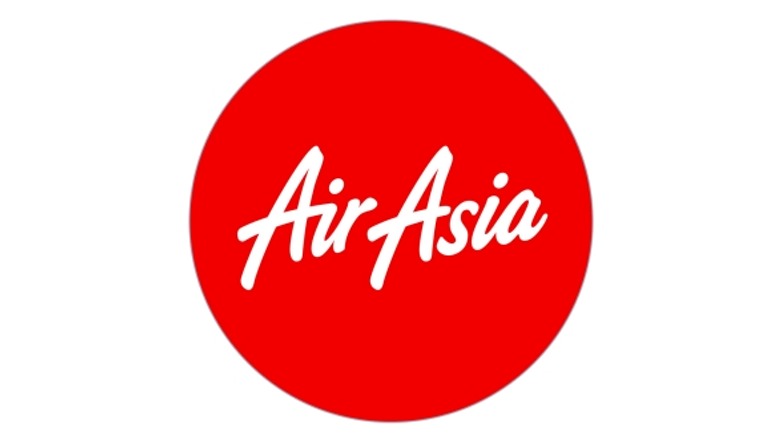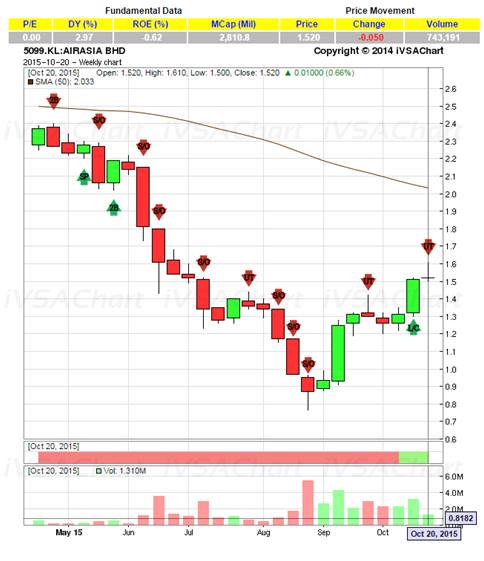Holistic View of AirAsia with Fundamental Analysis & iVolume Spread Analysis (iVSAChart)
Joe Cool
Publish date: Wed, 21 Oct 2015, 12:04 AM
Now everyone can fly, but can AirAsia investors fly?

On 8 December, 2001, Tune Air Sdn Bhd officially acquired 99.25 per cent equity (51.68 million shares) in AirAsia from DRB-Hicom, one of Malaysia's giant conglomerates. Tune Air Sdn Bhd is the holding company, while AirAsia remains as the operating company. With this acquisition, AirAsia, Malaysia's second national airline, became Asia's first low fare, ticketless airline.
AirAsia currently operates over 100 point-to-point domestic and international flights from its hubs in Kuala Lumpur International Airport (KLIA) and Senai Airport, Johor Bahru in Malaysia; Bangkok International Airport in Thailand; and Soekarno-Hatta International Airport in Jakarta, Indonesia.
AirAsia offers a simple 'no frills' service at fares that are on average significantly lower than those offered by traditional full-service airlines. Modeled on successful low fare airlines such as the U.S.-based Southwest Airlines and Dublin-based Ryanair, AirAsia was established to create a new aviation product in Malaysia, one that would revolutionise air travel, and grow the local aviation market by providing incredibly low fares so more people can fly.
This close to our heart airline company isn’t small at all, with a RM 5 billion annual revenue recorded in the latest full financial year report (2014). Although being a popular brand especially in the Asia region, there are many financial aspects that investor must look into carefully before making an investment in this well known airline.
|
Company |
AirAsia Bhd (FY 2014) |
|
Revenue (RM’000) |
5,415,744 |
|
Net Earnings (RM’000) |
82,836 |
|
Net Profit Margin (%) |
1.53 |
|
Total Debt to Equity Ratio |
2.793 |
|
Current Ratio |
0.594 |
|
Cash Ratio |
0.340 |
|
Dividend Yield (%) |
0.00 |
|
PE Ratio |
50.73 |
Revenue of AirAsia Bhd had been growing very consistently, which means that it has a good competitive advantage, resulting in stable and growing market share in the low cost airline industry. The company has achieved year to year average revenue growth of 26.216% which is pretty remarkable.
However, other than its outstanding year to year revenue growth, the financial performance of AirAsia are quite disappointing, mainly due to the highly competitive environment of the airline industry. Net earnings of AirAsia had been a roller coaster ride for the past 10 years. If we narrow down our analysis to the most recent 3 financial year, AirAsia had a massive decline in earnings from RM1.88 billion (FY2012) to RM 82.8 million (FY 2014), which translates to more than 50% decline in just 2 years. The sharp decline in net earnings explains why the net profit margin of AirAsia is barely 1.53% in FY 2014, whereby it use to have 20 to 30 % margin during the good years.
Another alarming aspect of AirAsia’s financial figures is its Total Dept to Equity Ratio. With a 2.793 ratio, it means that the total dept incurred in this company is 2.793 times of the total company’s capital (shareholder’s equity). Moreover, both current and long term liability of the company has been ballooning for the past 10 years. Take long term liability for example, it has grown from RM13.8 million to RM12 billion in 10 years. This translate to an average year to year growth of 110%, an extremely worrying figure. Such high debt incur by the company explains why the both Current Ratio and Cash Ratio are at the low side of 0.594 and 0.340.
In terms of dividend payout, AirAsia have not been paying dividend since financial year 2013, hence it is a no no for dividend seekers.
Note: There is no calculation of Intrinsic Value for AirAsia as it is still loss making.
iVolume Spread Analysis (iVSA) & comments based on iVSAChart software toolkit - AirAsia

iVSAChart Comment:
On Airasia weekly chart, it looks like in medium term trend stage 4 may had reversed to stage 1 evidenced by bullish 2 bars reversal at week 4 sep and subsequent wide spread bar with high volume starting a possible stage 2. This reversal at high volume could be caused by speculated privatization plan reported in the media.
However, on week 25 Sep there was an upthrust bar but at high volume as price was testing recent resistant area but unable to close higher as there are still many sellers at this level.
Subsequent bars indicated sideway trend in stage 2 at high volume (could be absorption). There seems to be a support at RM1.20 level. If the price retest recent resistant of RM1.42 and successful then stage 2 will continue.
However since background is still in red colour, need to monitor closely with tight stop loss for potential break of support line of RM1.20 since breakthrough this level may means continuation of stage 4 again especially if it also break support level at recent low of RM0.86.
In summary, there is a popular quote by Richard Branson who is the founder for Virgin Airlines: “If you want to be a Millionaire, start with a billion dollars and launch a new airline.”. Airline industry is highly competitive in nature and hence it is extremely difficult to achieve stable earnings. Incurring high debt is also part of the airline industry nature as buying new aircraft for expansion is inevitable. Companies with such high debt will place itself in a very vulnerable position especially during the recession period. AirAsia although being one of the best low cost airlines in the world have no exception in having these unfavourable qualities. Investors are advised to think twice not only investing in AirAsia, but also investing in other airline companies.
iVSAChart is also indicating likely profit taking coming after moving from RM 1.10 to RM1.50
(Share price on 20 October 2015: RM 1.52)
Related Stocks
| Chart | Stock Name | Last | Change | Volume |
|---|
More articles on iVSA Stock Review
Created by Joe Cool | Dec 15, 2016
Created by Joe Cool | Dec 15, 2016
Created by Joe Cool | Dec 01, 2016
Created by Joe Cool | Dec 01, 2016
Created by Joe Cool | Nov 14, 2016
Created by Joe Cool | Nov 03, 2016
Created by Joe Cool | Oct 24, 2016
Created by Joe Cool | Oct 24, 2016
Created by Joe Cool | Oct 17, 2016
Discussions
"In terms of dividend payout, AirAsia have not been paying dividend since financial year 2013, hence it is a no no for dividend seekers."
i am pretty sure i received my dividend yearly from 2013...
2015-10-21 13:09
You say "had a massive decline in earnings from RM1.88 billion (FY2014) to RM 82.8 million (FY 2015)" Not from FY2012 to FY2014 meh?
Q&A: Whats the reason for the spike in earning FY2012? Revenue didnt increase that much woh... U sure its ok to compare like dat r?
Q&A: At which part in your chart, it show take profit? U sure its not because chart was generated after ppl take profit r?
2015-10-21 17:38
Holistic?!
Far from it... this has got to be the briefest... most superficial.... and full of errors... article on AirAsia that I have read in a while... WTF!
2015-10-21 17:50









.png)









AyamTua
AAX !
2015-10-21 06:54